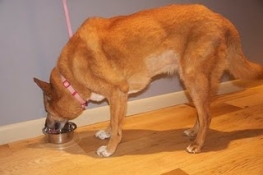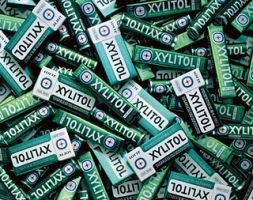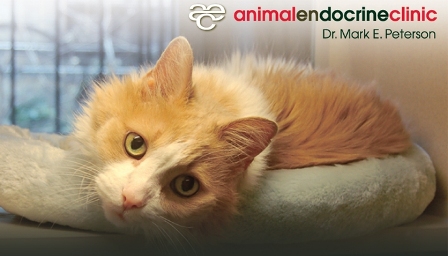Despite its name, diabetes insipidus is not related to the more commonly known diabetes mellitus, and it does not involve insulin or sugar metabolism. The name comes from Greek, where it is roughly translated to mean the “excessive discharge of bland urine.” This is in contrast to diabetes mellitus, which can be translates as the “excessive discharge of sweet urine.”
Diabetes insipidus is caused by problems with antidiuretic hormone (ADH or vasopressin), a pituitary gland hormone responsible for maintaining the correct level of fluid in the body. Either the pituitary gland does not secrete enough of this hormone (called central diabetes insipidus), or the kidneys do not respond normally to the hormone (called nephrogenic diabetes insipidus).
Affected dogs urinate in large volumes and drink equally large amounts of water. The urine is very dilute even if the animal is deprived of water (normally, urine becomes more concentrated when an animal is dehydrated.).
Increased urination may be controlled using desmopressin acetate, a drug that acts in a way similar to antidiuretic hormone. Water should not be restricted. Treatment is usually life-long.
Źródło: animalendocrine.blogspot.com
The holidays have gone by, but many of us still have candies lying around the house. Xylitol is an artificial sweetener found in many chewing gums and other candies, and it is extremely toxic to dogs. We add xylitol to candy because it tastes like sugar, but our body does not digest it – it contains no calories. While it is safe for us, it is very dangerous for dogs.
How does xylitol hurt my dog?
Unlike us, when a dog ingests xylitol (such as by getting into a pack of gum), the dog’s body falsely recognizes it as a tremendous amount of sugar. This causes the dog’s pancreas to release a lot of insulin, as if the dog’s blood sugar were very high. Because it is not actually high, this increase in insulin causes a dangerous drop in blood sugar (hypoglycemia). While some dogs merely develop temporarily elevated liver enzymes, suffer from acute liver failure, hemorrhage, blood coagulation, and death.
How much xylitol is dangerous?
It takes only one or two pieces of gum to cause toxicity in a 10kg dog (about 22 lbs). If your dog eats chewing gum or a candy containing xylitol, you should immediately call Animal Poison Control at (888) 426-4435 or contact your veterinarian / an emergency clinic.
Is xylitol dangerous to cats?
We know little about how xylitol affects cats, but it may not be toxic. If your cat ingests xylitol, you should watch your cat carefully, but you do not need to call animal poison control.
Źródło: animalendocrine.blogspot.com
Diabetes mellitus (often called simply diabetes) is a disorder in which the level of sugar in the blood is too high. In dogs, it is usually caused by a deficiency of the hormone insulin. During digestion, carbohydrates are broken down into glucose (a simple sugar), which is absorbed into the bloodstream. Once in the bloodstream, glucose must enter the body?s cells in order to be used for energy. Insulin signals the body?s cells to absorb glucose from the blood.
A lack of insulin creates two dangerous conditions. First, the body?s cells cannot absorb glucose without insulin; they begin to starve despite the abundant glucose. Second, because the body?s cells do not absorb glucose, the blood glucose level remains dangerously high.
With its cells starving for energy, the body begins to break down its protein, stored starches, and fat. As muscle is broken down and carbohydrate stores are used up, weakness and weight loss occur. As fat is broken down, substances called ketones are released into the bloodstream where they can eventually cause diabetic ketoacidosis, a severe complication of unregulated diabetes.
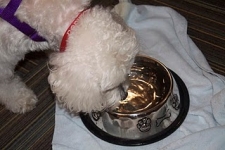 Meanwhile, the excess glucose circulating in the bloodstream can have harmful effects as well, including development of cataracts, pancreatitis, and skin and urinary tract infections. The excess glucose is eventually excreted from the body through the kidneys. As the glucose passes through the kidneys into the urine, it pulls water with it by diffusion. This causes increased urination, which leads to increased thirst.
Meanwhile, the excess glucose circulating in the bloodstream can have harmful effects as well, including development of cataracts, pancreatitis, and skin and urinary tract infections. The excess glucose is eventually excreted from the body through the kidneys. As the glucose passes through the kidneys into the urine, it pulls water with it by diffusion. This causes increased urination, which leads to increased thirst.
Diabetes often develops gradually, and owners may not notice the signs during the initial stage of the disease. Common signs include increased thirst and urination, increased appetite, and weight loss. Diabetic animals often develop chronic or recurrent infections. Dogs with poorly controlled diabetes often develop cataracts, which commonly leads to blindness.
A diagnosis of diabetes mellitus is based on finding high levels of sugar in the blood and urine.
To successfully manage diabetes, you must understand the disease and take daily care of your pet. Treatment involves a combination of weight loss (if obese), diet, and insulin injections generally twice daily. Usually after being diagnosed with diabetes, dogs are hospitalized for a day or two, and multiple blood samples are taken to measure the blood sugar level throughout the day. This information is used to determine the amount and timing of your pet?s meals and the dosage and timing of insulin injections. After this initial stabilization, your veterinarian will provide appropriate instructions on managing this regimen at home. Periodic reevaluation is necessary to ensure that the disease is being controlled. Based on these reevaluations, you may have to change your pet?s treatment regimen over time.
Źródło: animalendocrine.blogspot.com
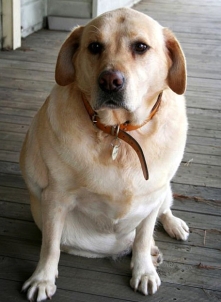 We are an overweight society and our pets are no different. By far, the most common explanation for an overweight pet is simple: lack of exercise and too much to eat. But what if you feed your dog sensibly, exercise adequately, and your dog still has a weight problem?
We are an overweight society and our pets are no different. By far, the most common explanation for an overweight pet is simple: lack of exercise and too much to eat. But what if you feed your dog sensibly, exercise adequately, and your dog still has a weight problem?
There could be a number of reasons your dog is still overweight, including heredity, temperament, and overall activity level. However, a disease may be causing your dog to become overweight or obese. Hormonal diseases such as hypothyroidism and Cushing?s syndrome commonly cause weight gain. Hormone pills or tablets with cortisone-like drugs could also be contributing to the obesity.
Hypothyroidism is deficient thyroid hormone, and it causes alterations in cellular metabolism that affect the entire body. The dog may not feel like exercising and may gain weight because calories consumed are not matching calories expended. The weight gain then makes the dog feel like exercising even less. Hypothyroidism is usually inherited and a common genetic illness in dogs. Untreated hypothyroidism means a lower quality of life for your dog, but with the proper thyroid supplementation, this condition can be easily controlled, allowing your dog to enjoy a good quality of life.
Cushing's syndrome (hyperadrenocorticism) is chronic excess of a glucocorticoid hormone, cortisol. This hormone is essential for functions such as maintaining blood glucose levels, metabolizing fats, keeping major organs functioning properly. There are different types of Cushing?s with many symptoms and causes, so it can sometimes be difficult to diagnose. Furthermore, its onset is slow, so its symptoms are often mistaken for signs of age. Cushing?s syndrome can cause reduced activity, change in appetite, and hair loss. Other symptoms include an increased thirst and urination, muscle weakness, and obesity. The cause of the Cushing?s syndrome determines the treatment, which is also influenced by the overall health of the dog.
Adequate exercise and proper diet are essential for all animals, but if your dog is overweight and you suspect an underlying disease, see a veterinarian for a thorough physical exam including laboratory tests.
Źródło: animalendocrine.blogspot.com
We are very proud of the warmth and quality of care that our hyperthyroid cat patients receive while they board with us after their radioiodine treatment. This fun video will give you a better idea of what it actually feels like to be a cat boarding in our state-of-the-art facility. The Hypurrcat Spa at The Animal Endocrine clinic is a warm, welcoming and comfortable facility, staffed by the world's leading veterinary endocrinologist, Dr. Mark E. Peterson.
For more information, please visit our website or call us at (212) 362-2650.
Źródło: animalendocrine.blogspot.com
Thyroid hormone is produced by the thyroid glands, small glands located in the neck. Thyroid hormone plays a very important role in regulating metabolism and proper functioning of the body.
Why is so important to diagnose and treat hypothyroidism?
The thyroid is responsible for the proper functioning of the heart, lungs, digestive system, skin, and brain as well as for strengthening hair and bones. It also helps the body convert calories into energy and process carbohydrates and fats.? During growth and development, thyroid hormones play an essential role in normal formation of the neurologic and skeletal systems. Puppies and kittens that develop congenital hypothyroidism show dwarfism or very stunted growth as one of the main clinical signs or symptoms.
In the adult dog or cat, thyroid hormones function affect the function and metabolism of virtually all tissues and organs in the body. Because thyroid hormone is central to many processes in the body, this means that dogs with hypothyroidism can show a wide range of signs. These signs often develop slowly and are not always very obvious to the dog owner. Sometimes the signs are confused with those of normal aging.
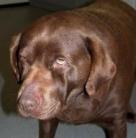 Mental changes:
Mental changes:• Lethargy
• Slow movements or reluctance to go for walks
• Increased time spent sleeping
• Lack of endurance; easily tired
• Increased sensitivity to cold
Weight changes:
• Tendency to gain weight, even on the same diet
• Inability to loss weight, even if less food is fed
Skin changes:
• Tragic facial expression, puffy face or dropping of the upper eyelids
•
• Dry, coarse, thin or sparse coat
• Lack of hair regrowth, e.g. after clipping
• Dry and flaky skin (dandruff), that is not usually itchy
• Loss of hair on tail (eg, rat tail)
• Thickening of skin
• Darkening of the skin (hyperpigmentation)
• Dry and flaky or very oily skin
• Recurrent skin infections
Neurologic abnormalities (rare):
• Seizures
• Vestibular disease
• Peripheral neuropathy
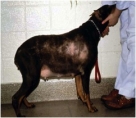 Which dogs are most likely to be affected with hypothyroidism?
Which dogs are most likely to be affected with hypothyroidism?Virtually all breeds, including mixed breeds, can be affected by hypothyroidism. However, Labrador retrievers, Golden retrievers, Doberman pinschers, Cocker spaniels, and Boxers are among those breeds that are predisposed to develop the disease.
Dogs between 2 and 6 years of age are more commonly affected. Male and female dogs are affected in equal numbers.
How do dogs develop hypothyroidism?
About 50% of the time it is caused by a condition called lymphocytic thyroiditis, an immune-mediated condition where the body starts to create antibodies to the thyroid tissue. Other causes can be due to a cancer of the thyroid gland, a secondary condition involving the pituitary, or for unknown reasons, what we call “idiopathic.”Hypothyroidism in dogs is most commonly caused by destruction of the thyroid gland itself, which leads to the deficiency in thyroid hormone in the blood stream. Two conditions are incriminated in over 95% of cases of primary hypothyroidism in dogs. In lymphocytic thyroiditis, the body produces antibodies against the cells in the thyroid gland that destroy of the thyroid gland. With the second cause of hypothyroidism (idiopathic atrophy), cells of the thyroid gland are replaced by fat cells. The cause is not known but it thought to reflect the end-stage process of lymphocytic thyroiditis in most cases.
Signs of hypothyroidism only develop after about 75% of the thyroid gland is destroyed. This process of destruction is gradual but slowly progressive, taking from 1 to 3 years in most dogs before a diagnosis is made.
Źródło: animalendocrine.blogspot.com
As you can see in the above video, before treatment she was getting ready to go into a hyperthyroid crisis (sometimes called a thyroid storm). She was experiencing severe heart issues, including tachycardia (rapid heart rate) and ventricular arrhythmia (irregular heartbeat), due to her hyperthyroidism. She was anxious, agitated, panting, and underweight.
The second video shows the same cat, after she has been cured of her hyperthyroidism with a radioiodine treatment at the Hypurrcat Spa. This video is taken 3 months after her I-131 treatment. She is now relaxed and she has gained weight back. Recent blood tests reveal that her T4 level has returned to normal, meaning that she is now cured of hyperthyroidism.
For more information about feline hyperthyroidism, please visit the Animal Endocrine Clinic website, the Hypurrcat website and Facebook page, or follow us on Twitter. You may also call us for more information: (212) 362-2650.
Źródło: animalendocrine.blogspot.com
Dr. Mark E. Peterson is a world-renowned specialist in endocrinology (hormonal disorders) of the dog and cat. He specializes in endocrine problems such as diabetes, hyperthyroidism, hypothyroidism, Cushing's and Addison's disease.
Dr. Peterson served as head of endocrinology and nuclear medicine at The Animal Medical Center in New York for over 30 years. He now sees patients at his own private practice, the Animal Endocrine Clinic, with two locations in New York City and Westchester County. The AEC is the world's foremost animal clinic for feline and canine endocrinology and is the only veterinary hospital devoted entirely to animals with endocrine problems. Each location has a Hypurrcat facility dedicated solely to treating hyperthyroid cats with radioiodine. Dr. Peterson created his clinics in an environment that combines scientific knowledge with his compassionate care to effect a cure.
Dr. Mark Peterson is also very active in writing and teaching other veterinarians. He has published hundreds of journal articles, book chapters, and research abstracts and is the editor of a leading textbook on veterinary endocrinology. With more than 250 teaching presentations to his credit, Dr. Peterson is a frequent speaker at veterinary and medical seminars both in the United States and around the world.
Źródło: www.drmarkepeterson.com
Hypurrcat is a treatment center built exclusively for radioiodine treatment of cats with hyperthyroidism.
Feline hyperthyroidism was first documented 31 years ago by Dr. Mark E. Peterson and coworkers. Since then, hyperactive thyroid disease has become the most common hormonal disorder of domestic cats. Due to continued research, hyperthyroid cats now have the same therapeutic choices as human patients including medication to suppress the thyroid hormone production, surgical removal of the thyroid tumor, or radioactive iodine (radioiodine I-131) therapy to destroy the thyroid tumor responsible for the condition.
Of these treatment options, radioiodine therapy is considered by authorities to be the treatment of choice for this condition in cats. Overall, radioiodine provides a simple, effective, and safe cure, regardless of the cat’s age. If left untreated, however, hyperthyroidism can be fatal.
At Hypurrcat we can now easily and completely cure this disease with our radioiodine procedure, destroy your cat's thyroid tumor, and return your cat to a normal thyroid state.
Źródło: www.hypurrcat.com


